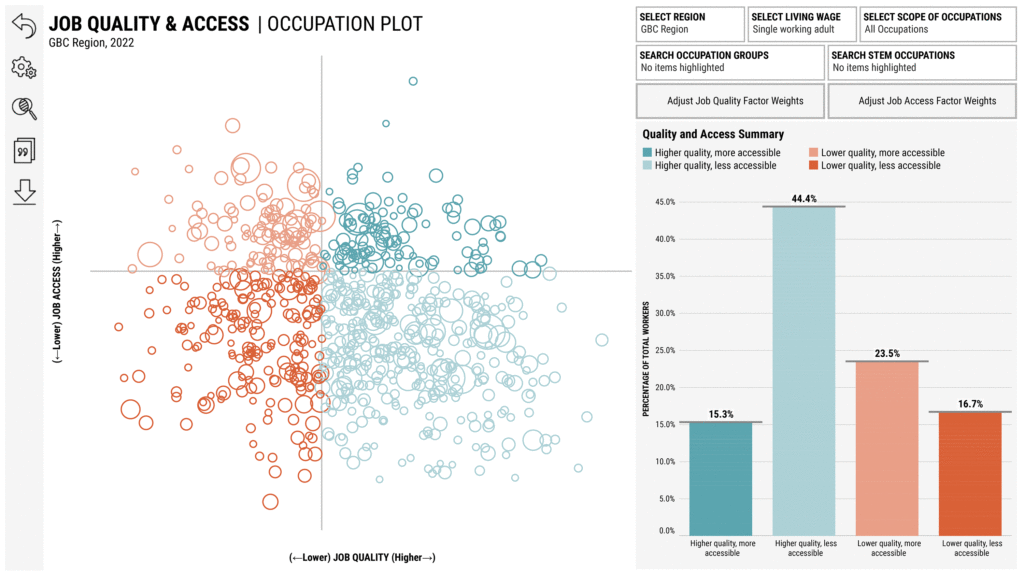“Quality jobs” is a phrase often touted by economic developers, employers, and politicians without much thought about what it means or how accessible these jobs are for workers. Community leaders rightly identify connecting workers to job opportunities and longer-term career paths as a critical component of sustainable economic growth, but supportive policymaking is hampered by a lack of information sharing and coordination among organizations. TIP strives to create strategies responsive to these challenges that are informed, at least in part, by our proprietary Job Quality and Access (JQA) tool. The JQA tool provides multi-dimensional workforce data that can be used to help identify higher quality and more accessible jobs across geographies.
First developed through a multi-year collaboration with the Chicago Metropolitan Agency for Planning (CMAP), TIP has created custom job quality and access analyses for regions across the country. Variations of the tool have featured visual comparisons of job and worker characteristics and have mapped worker density relative to transit availability. Clients who have explored the tool value how easy it is to use the unique compilation of data sets to drive decision making. An overview of how the JQA analysis measures job quality and access, and a closer look at versions created for two recent TIP clients, showcase the workforce insights generated by this highly adaptable tool.
Measuring Job Quality and Access
Measuring job quality has typically meant looking at how much a worker earns, omitting other important facets of a worker’s experience. TIP uses a nuanced approach to job quality that includes earnings in the context of local cost-of-living as well as other factors such as whether the job offers greater earnings opportunities through career advancement, whether it is expected to be stable over time, and whether other non-compensation benefits are likely to be provided. These benefits generally include employer-sponsored perks, such as access to childcare, personal leave, and healthcare coverage.[1]
Taken together, this approach scores a job (classified by occupation) as higher quality if it tends to satisfy a baseline living wage, has multiple related occupations that can offer higher earnings, is at least as stable as employment in the region overall, and offers benefits more frequently than the average.
Like job quality, TIP approaches job access with a broad-based, equity lens that considers barriers to entry as measured by education and experience requirements, job flexibility, and demographics. If a job tends to require at least a bachelor’s degree or more than two years of work experience, it is categorized as having higher barriers to entry that limit the pool of potential applicants and, therefore, access. Conversely, jobs that offer greater flexibility in day-to-day tasks, guarantee more dependable schedules, demand fewer weekly hours, or permit above-average rates of remote work tend to expand the number of potential workers and increase access.
While race, ethnicity, and gender should not directly influence hiring decisions,[2] demographics continue to impact the ability of marginalized groups to enter certain jobs. To provide a comprehensive view of job access, TIP’s analysis compares the demographics of each occupation to the composition of the overall region. If the job’s demographic composition mirrors that of the region, it suggests all groups have a chance of entry that is proportional to their presence in the region—in other words, equitable access. In contrast, a mismatch between a job’s composition and the region’s demographics indicates it is less accessible to certain groups.
The resulting scores assign each of the region’s occupations to one of four categories based on their job quality and access relative to the baseline average: higher quality and access, lower quality and access, or a combination of the two. Though both scores attempt to be holistic in their definitions, understanding the local socioeconomic context of the regional workforce is key to interpreting quality and access. This is especially important in more dense metropolitan regions where living experiences vary by neighborhood and block.
Job Quality and Access Plot Prepared for the Greater Baltimore Committee, April 2024

To emphasize how local socioeconomic factors can influence residents’ views of job quality and access, the JQA tool has evolved to include geospatial components showing the distribution of jobs in the context of a range of metrics on residents.[3] When public transportation is available, a sister analysis of transit access and demand can be overlaid on this geospatial component for additional context. TIP has used versions of this approach to job quality and access for clients in metropolitan regions (including Chicago and Baltimore), suburban communities (including in the Kansas City and Minneapolis-Saint Paul metros), and more rural areas (including the Texas panhandle). Each geography faces unique workforce challenges, and in each case, the job quality and access scores change to reflect local context and priorities. The benefits of this responsive approach are apparent in the work TIP undertook for two recent clients, CMAP and the Greater Baltimore Committee.
The Cross-Section of Industry, Workforce, and Equity in Chicago
In late 2021, CMAP engaged TIP to craft a strategy for connecting workers in communities and occupations disproportionately affected by the COVID-19 pandemic with employment opportunities. The resulting Inclusive Growth Analysis focused on the intersection of traded sectors and equitable growth. It was accompanied by an occupational accessibility tool designed to help local workforce development partners support inclusive and resilient economic growth by highlighting higher quality, more accessible jobs in key regional industry clusters. CMAP later asked TIP to create an updated version of the tool reflective of user-requested changes that would allow the data to better inform their work. This practitioner-driven update created an opportunity to incorporate new data, integrate additional features, and create a better user experience through a streamlined interface. The new tool was renamed the Job Quality and Access Analysis to emphasize practitioners’ primary focus areas.
Major updates to the new JQA tool included adjustments to the methodology, new customizable features, and more transparent descriptions of the data and instructions. The revised job quality score reoriented job earnings by making comparisons to a regional living wage and added new factors, such as a career opportunity measure and indicators of non-compensation benefits. Changes to job access focused on honing the demographic composition measure and incorporating structural job characteristics such as the ability to work remotely—a means of improving job access that has only increased since the onset of the pandemic.
User feedback from CMAP led to a new discussion: how should the variety of metrics be translated into scores that would resonate with diverse users from different practice areas and regions in Chicagoland? To address this array of perspectives, the tool had to become more dynamic. The scope of the analysis already considered the location-dependent nature of wages, job stability, and demographics. Shifting to a comparison with the regional living wage meshed with this geographic perspective and added the ability to select a comparable household type (i.e., a single adult versus a family of five). Building on the idea that job quality and access are relative, the updated tool allowed users to weigh the importance of each factor individually. This feature supports customized interpretations of job quality and access based on an individual’s perspective, guided by TIP’s expertise.
In addition to developing a new-and-improved tool that includes built-in instructional overlays, TIP created an outreach strategy for CMAP to train new staff and organizations on the tool. A self-help user reference guide and instructional videos from senior TIP staff demonstrating the potential uses and applications of the tool accompanied this strategy. As a result, community leaders in economic development, workforce, and education were better equipped to use nuanced data from one centralized resource with results tailored to the Chicagoland region.
“TIP Strategies worked closely with CMAP and our user group to push the JQA tool to new and exciting places. The additions of transit information, living wage, and allowing users to weight factors according to their needs has resulted in a tool that our region can utilize in multiple ways. The updated JQA tool helps CMAP, and our partners, better understand the context around workforce and job data, providing a window into what the data really means on the ground for our region’s residents. It supports better planning and decision making for our region.”
— Katie Reigstad, AICP, Senior Planner, CMAP
Transformational Change and Opportunity in Baltimore
In 2023, the Greater Baltimore Committee (GBC) called for the creation of a regional strategy centered on advancing economic opportunity. Developed with input from an array of partners and stakeholders, All In | 2035: A Ten-Year Economic Opportunity Plan for the Baltimore Region (All In | 2035) articulates a bold agenda that will guide GBC’s organizational priorities, as well as private and public investments, over the next decade. The plan’s forward-looking approach reflects GBC’s desire to ignite transformational change and spur new regional collaborations
As part of this effort, TIP prepared a customized JQA tool that highlights the Baltimore region’s competitive advantages, identifies future challenges, and complements the plan’s in-depth data analysis and extensive stakeholder engagement. To reflect GBC’s areas of emphasis, the tool gained an additional feature highlighting healthcare, life sciences, and STEM jobs in the region, which tend to be higher quality and less accessible than the average. Although this outcome was expected because these fields often require advanced training and receive higher compensation, the demographic distribution of workers across the region indicated inequitable job access for certain populations. In response to this insight, TIP undertook a parallel regional analysis of transportation access and demand that explored how to better connect the regional workforce with the opportunities concentrated in the urban core. By overlaying areas of high demand, identifying key transit hubs, and incorporating the spatial perspectives already inherent in the job quality and access scores, the resulting tool provided a more comprehensive landscape of the regional workforce to help guide future investment opportunities.
Continued Development and Future Uses
The continued evolution of TIP’s JQA tool reflects its adaptability to regional priorities and its ability to improve understanding of local workforce challenges. These bespoke tools assist communities in decision-making and provide opportunities for TIP to enhance existing analytical methods. Two key insights have emerged from the versions of the tool created for clients across the country: the multifaceted nature of job access and the importance of in-depth career pathways analysis.
While an earlier iteration of the tool approached access from a broad occupational perspective that included barriers to entry, work structure and flexibility, and demographic alignment, the geospatial aspect of physical access to jobs arose from the engagements with CMAP and GBC. Adding a separate but overlapping transportation analysis enhanced the concept of job access with a transit-oriented approach that can be especially illuminating in regions with existing (or planned) public transportation systems. Similarly, the addition of a career opportunity factor to measure job quality arose from conversations with stakeholders in the Chicago region. A consistent theme across workforce-oriented projects has been the need to better understand these opportunities and highlight career pathways that align with job quality and access, a component that will be considered in future iterations of the JQA tool, as well as other yet-to-be developed analytical tools. As TIP continues to engage clients on the diverse challenges that face their communities, the JQA tool will adapt features and inspire other analytics to help meet workforce-related challenges with creative approaches to data and strategy development.
[1] In some cases, the unionization rate is also considered as a benefit since being a union member influences other benefits.
[2] Employment discrimination is prohibited under Title VII of the Civil Rights Act of 1964 (https://www.eeoc.gov/statutes/title-vii-civil-rights-act-1964).
[3] Metrics can include population demographics; educational attainment; labor force status; income; housing; and access to healthcare, computers, and the internet.



